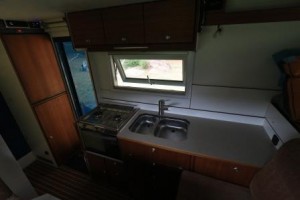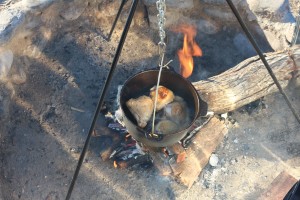We have received a few questions on what overlanding kitchen equipment we carry for food preparation and cooking on the road. I’m no expert Nigella ‘Domestic Goddess’ Lawson on culinary matters, but we do have the luxury of time to prepare things and we try to have a reasonably healthy diet. Our needs and preferences have changed a bit over our years on the road, but here’s what we have found so far:
Kitchen Gadgets & Small Equipment
In the kitchen you obviously need the actual kitchen sink, but do you need the proverbial kitchen sink? What is useful and what is a waste of precious space and weight with food and cooking for overland travel? A definitive list will depend on things such as: the sort of food you like, how you plan to cook (on gas hob, wood fire or bbq etc), how creative/adventurous you want to be with your cuisine, and the extent to which you have Gordon Ramsey’s culinary skill.
Everyone we meet on the road has their favourite ‘foodie travel gadget’. In particular, excellence in coffee-making seems to raise exacting standards amongst some travellers (naming no names… but Peter Wroblowski’s fine cappuccinos spring to mind here 🙂 )! Here are a few particular pieces of equipment, in no particular order of importance, that I wouldn’t be without:
- Pans: Set of Tefal Ingenio non-stick pans with ‘quick-clip’ handles, plus a full set of glass cooking lids and plastic snap-on lids. Set also includes a veg-steamer pan. (In a dismal failure to recognise Cuthbert’s globlal influential profile, Tefal is sadly not making any financial inducement for our endorsement of this product! Nevertheless, we still have to say that their Ingenio range is just brilliant for a miniscule kitchen).
- Scales: Fold-out, accurate digital food scales (I like the Tri-scale by Joseph Joseph, but yet again the value of Cuthbert’s endorsement of this product goes unrewarded 🙂 !)
- Chopping Boards: Flexible ‘paper-thin’ plastic chopping boards
- Knives: A couple of top-notch chefs’ knives (in a somewhat misguided romantic notion that we might catch fish for supper, I bought an expensive fileting knife that still sits in the drawer – almost entirely unused but I can’t throw such an expensive item away!)
- Blending: Electric ‘whizzy stick’ – food blender with blender blades and whisk attachments (what can’t you do with this thing… scrumptious milkshakes, soups, fruit juices and, and, and…)
- Storage and spill-avoidance: Unlike in a house, you can’t just stand open containers or bags in a fridge or cupboard – everything needs to be spill-proof and break-proof for bouncing around on dirt-roads. We use lots of snap-shut tubs, zip-loc bags (reused wherever possible) and clip-seals for sealing open packets of pasta etc.
- Flask: for keeping pre-cooked food warm (and particularly essential for making yoghurt) I carry a 500ml food flask
- Cast-iron Dutch Oven: In Africa and South America we used to carry a cast-iron Dutch Oven (known as a ‘potjie’ in Africa) for outdoor cooking on coals or fire. But in recent years we found we weren’t cooking outside and this is a large/heavy item to carry if it’s not much-used.
Refrigeration
Good refrigeration is quite important with food and cooking for overland travel – at least it is if you want to have cool drinks, fresh food and stay healthy! Cuthbert is fitted with an ‘ordinary’ Waeco Coolmatic MDC-90 fridge/freezer, the kind commonly found in road-going RVs/caravans. On our initial ‘test trip’ around Europe during winter/spring 2014 it was fine. But once we got to Africa two factors started to irritate us about this fridge:
- When the external temperature started to rise over 30°C, the cooling system could not cope and the in-fridge temperature regularly rose well over 10°C for extended periods. The fridge housing cabinet is well vented, but when we are in the hotter areas the cooling capacity is not really satisfactory and food sometimes has to be wasted.
- As the fridge is fitted to face backwards, the door regularly flies open (depositing most of the contents on the cabin floor!) when we drive up steep hills, particularly when on a rough road or going over a speed-bump on a tarred road. The fridge is fitted with a flick-catch door lock, but this is obviously not sufficiently strong.
With the benefit of experience and hind-sight we would plan the refrigeration differently. When we lived in the Middle East we had an Engel trunk-fridge fitted in the back of our Toyota Fortuner. Having this kind of fridge in Cuthbert would solve both of our problems. First, the Engel coped most capably with external temperatures frequently over 40°C for extended periods, and sometimes even over 50°C. Secondly, its latch-lock top-lift lid could not (in any road conditions) open to deposit the contents. Unfortunately, changing this now would require a significant re-design of the Cuthbert’s interior. For now we’re living with the Waeco fridge and have made a few modifications to assist its performance. We have fitted:
- A temperature monitoring system with an external digital display of the temperature, so that we can keep an eye on the internal temperature.
- Extra cooling fans in the space behind the fridge. This helps keep it cool and relieve some of the strain on the fridge cooling mechanism.
- Clear plastic/polythene sheet-flaps hanging down in front of the shelves.
- Small swivel catches on either side of the freezer door. These hold it tight shut and help prevent ice forming on the outside of the freezer box.
- A simple external screw-lock mechanism on the fridge housing cabinet. This hooks around the door and prevent it from opening ‘on the move’.
All the above measures are helping to manage the fridge temperature. But monitoring this, ensuring that it is cool enough when we are in hot areas, and preventing it from freezing everything when we visit cooler areas (particularly at night) is an on-going, constant balancing act.
Stove and Oven Cooking
For indoor cooking, Cuthbert is fitted with a Techimpex gas cooker with two hob-rings on top and a grill/oven underneath. We had a few ‘teething troubles’ with overheating damaging the oven-housing, but Bocklet were quick to resolve this for us. Since then we have been reasonably happy with it.
When weather and campsites permit, we like to cook outside on wood or charcoal. For this we love the cast-iron ‘Dutch Oven’ (or Potjie). We use this ‘Witch’s Cauldron’ style, hanging on a chain from a tripod over the fire. If you Google ‘Dutch Oven’ the results bring up lots of info on how to cook with these. They work well even for the ambitious cooks: baking bread and cakes etc.
So that’s what we do for food and cooking for overland travel. Of course you can always go to restaurants too when your in town 🙂 I’ve you’ve any comments or tips to share with me, I’d love to hear from you… just click to the Contact Page
Click here to go back to Overlanding KFC (Kitchen, Food & Cooking) home page


